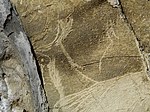Zarautz

Zarautz (Basque: [s̻aɾaut͡s̻] , Spanish: Zarauz) is a coastal town located in central Gipuzkoa, Basque Country, in Spain. It is bordered by Aia to the east and the south and Getaria to the west, located about 15 kilometres (9.3 mi) west of San Sebastián. It has four enclaves limiting the aforementioned municipalities: Alkortiaga, Ekano, Sola, and Arbestain. As of 2014, Zarautz has a population of 22,890, which usually swells to about 60,000 in the summer. The Palace of Narros, located adjacent to Zarautz's 2.8 km (1.7 mi) long beach, is where Queen Isabella II and Fabiola of Belgium once spent their summer holidays. The beach is known for being the longest in the Basque Country and one of longest of the Cantabrian cornice. The Mayor of Zarautz since 2015 has been Xabier Txurruka (Basque Nationalist Party).
Excerpt from the Wikipedia article Zarautz (License: CC BY-SA 3.0, Authors, Images).Zarautz
Mitxelena kalea,
Geographical coordinates (GPS) Address Nearby Places Show on map
Geographical coordinates (GPS)
| Latitude | Longitude |
|---|---|
| N 43.283333333333 ° | E -2.1666666666667 ° |
Address
Mitxelena kalea 21
20800
Autonomous Community of the Basque Country, Spain
Open on Google Maps











